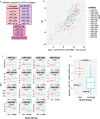MiRNA expression deregulation correlates with the Oncotype DX® DCIS score
- PMID: 36096802
- PMCID: PMC9469592
- DOI: 10.1186/s13058-022-01558-4
MiRNA expression deregulation correlates with the Oncotype DX® DCIS score
Abstract
Background: Current clinical criteria do not discriminate well between women who will or those who will not develop ipsilateral invasive breast cancer (IBC), or a DCIS recurrence after a ductal carcinoma in situ (DCIS) diagnosis. The 12-gene Oncotype DX® DCIS assay (RT qPCR gene-based scoring system) was established and shown to predict the risk of subsequent ipsilateral IBC or DCIS recurrence. Recent studies have shown that microRNA (miRNA) expression deregulation can contribute to the development of IBC, but very few have evaluated miRNA deregulation in DCIS lesions. In this study, we sought to determine whether specific miRNA expression changes may correlate with Oncotype DX® DCIS scores.
Methods: For this study, we used archived formalin-fixed, paraffin-embedded (FFPE) specimens from 41 women diagnosed with DCIS between 2012 and 2018. The DCIS lesions were stratified into low (n = 26), intermediate (n = 10), and high (n = 5) risk score groups using the Oncotype DX® DCIS assay. Total RNA was extracted from DCIS lesions by macro-dissection of unstained FFPE sections, and next-generation small-RNA sequencing was performed. We evaluated the correlation between miRNA expression data and Oncotype score, as well as patient age. RT-qPCR validations were performed to validate the topmost differentially expressed miRNAs identified between the different risk score groups.
Results: MiRNA sequencing of 32 FFPE DCIS specimens from the three different risk group scores identified a correlation between expression deregulation of 17 miRNAs and Oncotype scores. Our analyses also revealed a correlation between the expression deregulation of 9 miRNAs and the patient's age. Based on these results, a total of 15 miRNAs were selected for RT-qPCR validation. Of these, miR-190b (p = 0.043), miR-135a (p = 0.05), miR-205 (p = 0.00056), miR-30c (p = 0.011), and miR-744 (p = 0.038) showed a decreased expression in the intermediate/high Oncotype group when compared to the low-risk score group. A composite risk score was established using these 5 miRNAs and indicated a significant association between miRNA expression deregulation and the Oncotype DX® DCIS Score (p < 0.0021), between high/intermediate and low risk groups.
Conclusions: Our analyses identified a subset of 5 miRNAs able to discriminate between Oncotype DX® DCIS score subgroups. Together, our data suggest that miRNA expression analysis may add value to the predictive and prognostic evaluation of DCIS lesions.
© 2022. The Author(s).
Conflict of interest statement
The authors O.L., M.I.M., I.Z.B-D, and C.L. declare that they have no competing interests. S.F. declares having served on an expert panel for Genomic Health in 2017 and as an expert consult for AXDEV Group Inc.
Figures





Similar articles
-
Molecular markers of risk of subsequent invasive breast cancer in women with ductal carcinoma in situ: protocol for a population-based cohort study.BMJ Open. 2021 Oct 26;11(10):e053397. doi: 10.1136/bmjopen-2021-053397. BMJ Open. 2021. PMID: 34702732 Free PMC article.
-
Profiling differential microRNA expression between in situ, infiltrative and lympho-vascular space invasive breast cancer: a pilot study.Clin Exp Metastasis. 2018 Feb;35(1-2):3-13. doi: 10.1007/s10585-017-9868-4. Epub 2017 Dec 6. Clin Exp Metastasis. 2018. PMID: 29214365
-
Qualitative Radiogenomics: Association Between BI-RADS Calcification Descriptors and Recurrence Risk as Assessed by the Oncotype DX Ductal Carcinoma In Situ Score.AJR Am J Roentgenol. 2019 Apr;212(4):919-924. doi: 10.2214/AJR.18.20306. Epub 2019 Feb 4. AJR Am J Roentgenol. 2019. PMID: 30714832
-
Molecular Evaluation of Breast Ductal Carcinoma in Situ with Oncotype DX DCIS.Am J Pathol. 2019 May;189(5):975-980. doi: 10.1016/j.ajpath.2018.12.003. Epub 2018 Dec 31. Am J Pathol. 2019. PMID: 30605628 Review.
-
Can Molecular Biomarkers Help Reduce the Overtreatment of DCIS?Curr Oncol. 2023 Jun 13;30(6):5795-5806. doi: 10.3390/curroncol30060433. Curr Oncol. 2023. PMID: 37366916 Free PMC article. Review.
Cited by
-
How much do we know about the metastatic process?Clin Exp Metastasis. 2024 Aug;41(4):275-299. doi: 10.1007/s10585-023-10248-0. Epub 2024 Mar 23. Clin Exp Metastasis. 2024. PMID: 38520475 Free PMC article. Review.
References
Publication types
MeSH terms
Substances
LinkOut - more resources
Full Text Sources
Medical

